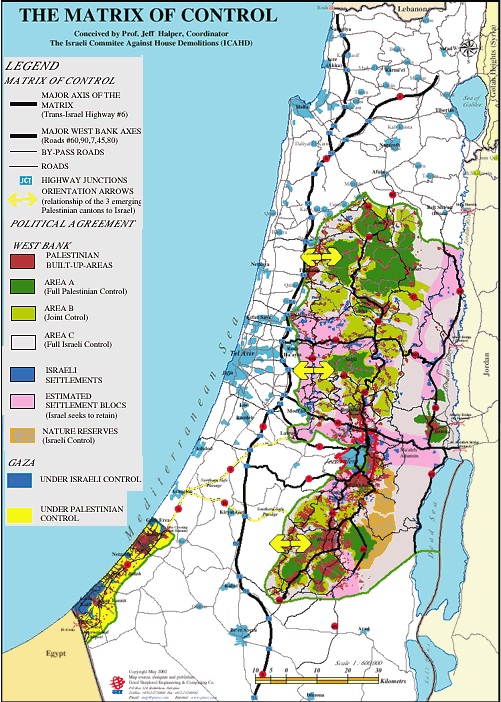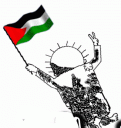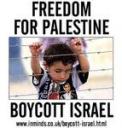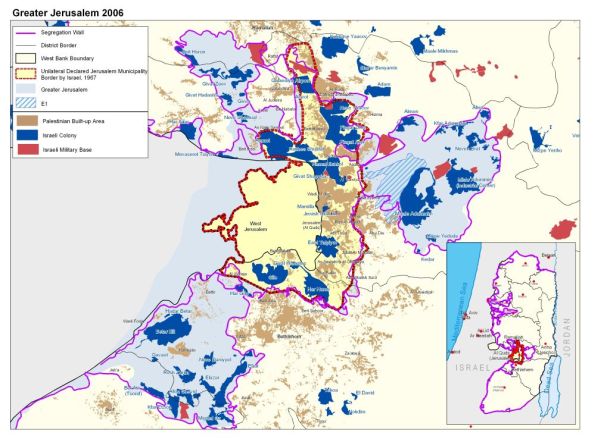From: Jeff Haper, Israeli Committee against House Demolitions (ICAHD.ORG)

In the complex situation in which Palestinians and Israelis currently find themselves, two things seems equally evident:
- First, a viable and truly sovereign Palestinian state alongside Israel is an absolute prerequisite for a just and lasting peace; and
- Second, Israel needs a Palestinian state. Without a Palestine state Israel faces what it considers as two unacceptable options. If it annexes the Occupied Territories and grants citizenship to their three million Palestinian inhabitants, it creates de facto a bi-national state of 5 million Jews and 4 million Palestinians (not counting the refugees), an option that would end the Zionist enterprise. If it continues its Occupation, it inevitably creates a system of outright apartheid, an untenable option in the long run.
So what’s the problem? Why did a decade of negotiations from Madrid and Oslo to Camp David and Taba end in such dismal failure, indeed, in an Intifada? What, indeed, must be done, not only to “restart the peace process,” but to ensure that it concludes with a just peace offering not simply security for Israel but also a truly sovereign and viable state for the Palestinians?
One indisputable fact that has accompanied the entire “peace process” is that Israel will simply not relinquish control voluntarily over the West Bank and East Jerusalem. It will not relinquish the core of its settlement system, or control of the West Bank aquifers, or sway over the area’s economy or it “security arrangements” extending over the entire Palestinian area.
This was the essence of the “take it or leave it” offer Barak and Clinton made at Camp David (the Palestinians left it), as well as that of the Taba negotiations in January, 2001
From Israel’s point of view, then, the trick is to find an arrangement that would leave it in control, but “relieve” it of the Palestinian population — a kind of occupation-by-consent. This was the essence of the “take it or leave it” offer Barak and Clinton made at Camp David (the Palestinians left it), as well as that of the Taba negotiations in January, 2001. The popular impression has it that Barak made a “generous offer” of 95% of the West Bank, plus considerable parts of East Jerusalem and all of Gaza, and that the Palestinians made an “historic mistake” in rejecting it. This has let Israel off the hook in terms of repressing Palestinian resistance. It has become fashionable, even among the moderate Israeli left, to blame the Palestinians for “spoiling” the peace process. They, after all, spurned Barak’s “generous offer” of 95% and reacted with “violence.” We, the Israelis, did our part. We were forthcoming. They are not ready for peace, do not want peace, are not “partners” for peace. We are OK; they are to blame for everything. They deserve anything they get. We are not responsible.
Look again at the map above and identify the green areas that are under “total” Palestinian control. Ask yourself one question: how does this “generous offer ” of giving the Palestinians 95% of scattered areas throughout the West Bank, choked and surrounded by Israeli Settlements, Planned Settlements and Israeli army control, become an offer “so generous” that Palestinians must accept? Who are the Israelis – and their NaZionist supporters – fooling? These are the same “supporters” blinded by the lies, their own opinions and “facts,” and still insist that such phony offers are their “proof” that Israel had made many “offers” for peace.
Barak’s “generous offer.”
First of all, there never was an Israeli “offer,” and Israel never proposed to relinquish 95% of the West Bank. At a desperate time when Barak knew he would lose the election, the Israeli delegation came to Taba prepared to talk about conceding 93% of the West Bank – with the Palestinians counter-proposing 97%. But they were not talking about the same land. Because Israel does not consider East Jerusalem and “No Man’s Land” around Latrun as part of the West Bank, but does include the part of the Dead Sea falling within the Palestinian territory, Barak’s 93% was actually more like 88% of the actual Palestinian territory.
The major fallacy in this view is to equate territory with sovereignty
The major fallacy in this view is to equate territory with sovereignty. Although gaining control of 95% or 88% of the territory is important – especially if the territory is contiguous — it does not necessarily equate with sovereignty. This is where the crucial issue of control enters the picture. The Palestinians could well receive 95% of the West Bank, Gaza and pieces of East Jerusalem and still not have the prerequisites of national self-determination: coherent territory, economic viability and genuine sovereignty.
you win by immobilizing the other side, by gaining control of key points of a matrix, so that every time your opponent moves he or she encounters another obstacle
Since 1967 – and increasingly since the Oslo Accords were signed in 1993 — Israel has laid a “Matrix of Control” over the West Bank, East Jerusalem and Gaza. The Matrix, an intricate and an interlocking series of control mechanisms, resembles the Japanese game of “Go.” Instead of defeating your opponent as in chess, in “Go” you win by immobilizing the other side, by gaining control of key points of a matrix, so that every time your opponent moves he or she encounters another obstacle. This strategy was used effectively in Vietnam, where small forces of Viet Cong were able to pin down and virtually paralyze some half-million American soldiers possessing overwhelming fire-power. In effect Israel has done the same thing to the Palestinians. Laid out strategically, the Matrix of Control paralyzes the Palestinian population even if Israel does not actually occupy large swathes of land. All the settlements and by-pass roads take up less than 5% of the land; “settlement blocs,” “security zones” and other forms of control can be expanded to include 12% of the land as in Barak’s conception or 56% as in Sharon’s. But these 5-12% are what makes the difference between a bantustan and a sovereign, viable state. From the point of view of control, 88% of the West Bank that the Palestinians might receive indeed, sounds “generous,” but it must be evaluated in light of the impact the other 5-12% have on Palestinian viability and sovereignty. Barak’s “offer” at Taba deserves to be looked at carefully, not because it was truly an “offer” or because it truly represented the Israeli position or a genuine possibility, but because, as Barak never tired of saying, it is by far the best “deal” the Palestinians will ever be offered, the most “generous,” a one-time “take-it-or-leave-it” that would be a “historical mistake” for the Palestinians to reject. If all this is true, would the so-called “95% offer” at Taba have led to a sovereign and viable Palestinian state? Would it have in fact dismantled Israel’s Matrix of Control? The answer to this “best case” scenario is “no.” The Palestinians gained a greater degree of territorial contiguity and control of their borders, though not of their water resources. But Taba did not break Israel’s hold on the Occupied Territories. On the contrary, it revealed how much Israel could relinquish and still retain control. Looked at closely, this is what the “generous offer” in fact offered (excerpts):
- In order to avoid international opposition to the establishment of new settlements, the government shifted to building new settlements within the expansive master plans around each settlement. In that way it was able to argue that it was simply “thickening” existing settlements to meet natural population growth (an outright falsification), not establishing new ones.
- The city of Ariel and its surrounding “Western Samaria” bloc control a strategic area on the western side of the West Bank, seriously compromising territorial contiguity and the coherent flow of people and goods between the major Palestinian towns of Kalkilya, Nablus and Ramallah. It would also severely restrict the urban development of the Kalkilya area. No less important than its strategic location on the ground is Ariel’s location vis-a-vis Palestinian resources under the ground: the Ariel bloc sits atop the major aquifer of the West Bank and would control the flow and distribution of water.
- There had been 21 armed disputes over water in recent history – and 18 of them involved Israel
- “We are talking about mainly the mountain aquifer and the Jordan River system. Regarding the first one Israel exploits approximately 80% of the renewal water resources, and the Palestinians the remaining 20%” said Yehezkel Lein, a water expert for Israeli human rights group B’tselem
- “Regarding the Jordan River system, the Palestinians do not have any access.” Yehezkel Lein stated. BBC News World Edition, June 2003.
- The central Givat Ze’ev-Pisgat Ze’ev-Ma’alei Adumim (and perhaps Beit El) bloc stretches across much of the central West Bank from the Modi’in area to within 20 kilometers of the Jordan River. It effectively divides the West Bank in two, compelling north-south Palestinian traffic (especially from Ramallah to Bethlehem and Hebron areas) to pass through Israeli territory – the funnel-like Eastern Ring Road. It also keeps the Palestinians of the West Bank far from Jerusalem, isolating the 200,000 Palestinians of East Jerusalem from their wider state and society, and cutting the natural urban link between Jerusalem and Ramallah. In terms of viability, this bloc, a main component of Israeli “Greater Jerusalem,” constitutes the greatest threat to a coherent Palestinian state.
- The Efrat-Gush Etzion-Beitar Illit bloc to the southwest of Jerusalem (yet connected through Gilo, Har Homa and the Eastern Ring Road/Road #7 complex to the Ma’aleh Adumim bloc) is the other key component of “Greater Jerusalem.” It also impacts seriously on the viability and sovereignty of any Palestinian state. The bloc severs any coherent connection between the major cities of Bethlehem and Hebron, as well as traffic using the “safe passage” from Gaza. It forces Palestinians moving between these areas to use Israeli-controlled “security” roads passing through dense areas of settlement, continually exposed to disruption and closure. It locks in Bethlehem to the extent of preventing its normal urban development. And, like the Ariel bloc, it sits astride and brings into Israeli control a major West Bank aquifer.
- The city of Ariel and its surrounding “Western Samaria” bloc control a strategic area on the western side of the West Bank, seriously compromising territorial contiguity and the coherent flow of people and goods between the major Palestinian towns of Kalkilya, Nablus and Ramallah. It would also severely restrict the urban development of the Kalkilya area. No less important than its strategic location on the ground is Ariel’s location vis-a-vis Palestinian resources under the ground: the Ariel bloc sits atop the major aquifer of the West Bank and would control the flow and distribution of water.
- The Creation of a “Greater [Israeli] Jerusalem.” The Givat Ze’ev-Adumim and Gush Etzion settlement blocs, 250 square kilometers containing some 80,000 settlers, when annexed to Israeli-controlled “Greater Jerusalem,” will dominate the entire central region of the West Bank and obstruct the territorial contiguity necessary for a viable Palestinian state.
- The Emergence of a “Metropolitan [Israeli] Jerusalem.” The ring roads and major highways being built through and around Jerusalem are intended to create a regional infrastructure of control, turning Jerusalem from a city into a metropolitan region. “Metropolitan” Jerusalem covers a huge area. Its boundaries, incorporating a full 10% of the West Bank (440 square kilometers), stretch from Beit Shemesh in the west up through Kiryat Sefer until and including Ramallah, then southeast through Ma’aleh Adumim almost to the Jordan River, then turning southwest to encompass Beit Sahour, Bethlehem, Efrat abnd the Etzion Bloc, then west again through Beitar Illit and Tsur Hadassah to Beit Shemesh. It also provides a crucial link to the Kiryat Arba and the settlements in and around Hebron. In many ways “Metropolitan” Jerusalem is the Occupation. Within its limits are found 75% of the West Bank settlers and the major centers of Israeli construction. Click Map to enlarge
- An East Jerusalem Patchwork. Between the negotiations at Camp David and Taba, various options were explored to give the Palestinians more of a presence in East Jerusalem, which they claim as their capital. The peripheral villages and neighborhoods to the north and south of the city might have been ceded, although the Palestinians might receive less than full sovereignty over them – “functional autonomy,” “administrative control” or “limited sovereignty.” In Taba Israel considered ceding some parts of the core areas as well: some of the “Holy Basin” between the Old City and the Mount of Olives, downtown East Jerusalem, the Sheikh Jarrah Quarter, and in the Old City the Muslim and Christian Quarters. The Temple Mount/Haram issue remained unresolved, with Israel prepared to cede “functional sovereignty” (though not official) to the “upper” area of the mosques, while retaining sole sovereignty over the “lower” Western Wall.
- Israeli Control over Highways and Movement. Over the past decades (and especially during the Oslo “peace process’), Israel has been constructing a system of major highways and “by-pass roads” designed to link its settlements, to create barriers between Palestinian areas and to incorporate the West Bank into Israel proper. Even if physical control over the highways is relinquished, strategic parts will remain under Israeli control – the Eastern Ring Road, Jerusalem-Etzion Bloc highway, Road 45 from Tel Aviv to Ma’aleh Adumim, a section of Highway 60 from Jerusalem to Beit El and Ofra, and the western portion of the Trans-Samaria highway leading to the Ariel bloc. In terms of the movement of people and goods, this will effectively divide the Palestinian entity into at least four cantons: the northern West Bank, the southern portion, East Jerusalem and Gaza. There are other restrictions as well. The “safe passages” from Gaza to the West Bank, crucial to the viability of a Palestinian state, will only be administered by the Palestinians; they will not receive extra-territorial status. And Israel insists on retaining rights of “emergency deployment” to both the highway system and to the Jordan Valley, severely compromising Palestinian sovereignty. Indeed, the highways would retain the status of Israeli “security roads,” meaning that Palestinian development along them would remain limited.
- Meeting Israeli “Security” Concerns. “Security” is defined by Israel in such maximalist terms that it ensures Israeli political, military and economic control. Israel insists that a Palestinian state will be demilitarized and forbidden to enter into military pacts with other states, that Israel controls Palestinian airspace, and that it reserves the right to deploy forces in the Jordan Valley in the indeterminate event that it perceived “a threat” of invasion. Controlling Palestinian labor and commercial movement through the imposition of “security borders,” part of Israel’s declared policy of “separation” from the Palestinians, constitutes additional constraints on Palestinian development, locking the less that 20% of Palestine that is the state from the other more than 80% that is Israel.
- Limited Palestinian Sovereignty. A Palestinian state would possess limited sovereignty only. It would be demilitarized and unable to form military alliances not approved by Israel. It would have jurisdiction over its borders, but would have certain restrictions as to who may enter (especially vis-a-vis the refugee issue). And the restrictions regarding military contingencies (defined by Israel) would apply.
The Only Way Out
If Israel can force or induce the Palestinians to accept the Camp David formula (or find a post-Arafat quisling to sign the bottom line), it will have succeeded in securing control over the Greater Land of Israel while having relieved itself of the Palestinian population of the Occupied Territories.
This is also true of Barak’s “generous offer” at Taba – Israel’s “best deal” (though it never really approached a concrete “offer” or “deal”). Again, it is not hard to understand why the Palestinians rejected it. Taba would have given Israel title to more than 80% of Palestine and control over the rest.
The Palestinians would have had to cede the elements essential to their self-determination: economic viability and developmental potential, territorial contiguity, true independence, a normal and sovereign civil society, recognized borders under their own control. Indeed, they were already skating on the thin edge of viability and sovereignty.
At Oslo the Palestinians gave up political claim to 78% of their country, and agreed to a mini-state of limited sovereignty: no army, no military alliances not approved by Israel, certain Israeli economic controls and even limitations on who may enter Palestine. Barak’s “take it or leave it” approach also prevented agreement. The Palestinians feared they would be doomed forever to a truncated, dependent, semi-sovereign mini-state, their hopes for a real country and the resolution of the refugee issue frozen within the parameters of Oslo, Camp David and Taba – and ultimately within the Matrix of Control.
Taba did show that peace was possible, but only if Israel truly dismantled its Matrix of Control.
Although it represents Israeli’s “best case” scenario, it may not even have been “real.” In articles and interviews Barak has given since leaving office, he has reiterated his old pre-Taba, Camp David positions — 80% of the settlers must remain under Israeli sovereignty; “separation;” Israel retains 15% of the West Bank, etc. Or did he agree knowing full well that any Taba agreement had no chance passing the Knesset? We will never know.
What we do have now is a Sharon-Peres government determined to break Palestinian resistance once and for all. Refusing to even consider picking up the negotiations from where they left off at Taba, Sharon has offered the Palestinians 42-56% of the West Bank (the present extent of Areas A and B with some corridors), none of East Jerusalem and a truncated Gaza. The Matrix of Control represents Israel’s success in establishing a system of control over the Occupied Territories that has lasted decades. Its usefulness does not end there. Because it renders the Occupation invisible, it is capable of deflecting opposition at home and abroad.
Although it was Israel who prejudiced the outcome of the Oslo negotiations by measurably strengthening its grip over the Occupied Territories and offering concessions that left its control intact, it is the Palestinians who have been almost universally blamed for the breakdown of the “peace process.” An understanding of the Matrix of Control is essential for comprehending the sources of the present conflict and the obstacles to its resolution. Only dismantling it will lead to a just and lasting peace. This is the only way that Israel’s long-standing and ongoing campaign of “creating facts on the ground” can be effectively neutralized.














[…] The truth behind Israel’s “generous” offer to the Palestinians https://attendingtheworld.wordpress.com/2008/02/03/the-truth-behind-israels-generous-offer-to-the-pa… […]
[…] The truth behind Israel’s “generous” offer to the Palestinians https://attendingtheworld.wordpress.com/2008/02/03/the-truth-behind-israels-generous-offer-to-the-pa… […]
[…] three million Palestinian inhabitants, it creates de facto a bi-national state of 5 million Jews ahttps://attendingtheworld.wordpress.com/2008/02/03/the-truth-behind-israels-generous-offer-to-the-pal…Center for Corporate Citizenship – What is Corporate CitizenshipThe Boston College Center for […]
[…] three million Palestinian inhabitants, it creates de facto a bi-national state of 5 million Jews ahttps://attendingtheworld.wordpress.com/2008/02/03/the-truth-behind-israels-generous-offer-to-the-pal…Hacked Elections – High Tech Election Theft in America – Buy the book!Truth Enterprises, LLC 7010 […]
Hi ATW;
I followed your link on my blog to your other post. I was extremely interested in it and am going to read it once more. I like the way you approached the subject matter and presented it.
I appreciate it.
Regards
Robert
Hi i am the son
That’s what the Israelis are trying to achieve: reduce the Palestinian people to a few tribes in certain reservations. The “plan” is obvious when one considers Israel’s history of terrorism.
But there are those who are Orthodox Jews and who are against Zionism and such plans. These people know something that Israel, a country of 60% who do NOT go to synagogues, refuse to believe. Actually, there are stats that claim that about 40% of Israelis are atheists! But that’s another story about … the “Jewish” State!
ATW
Hi ATW
The situation is similar to the American Indian living on “Reservations” in the United States.
Treaties were broken, and the once free and proud tribes reduced to ghosts of their former selves.
This is not a unique situation, what is unique is that there are less than ten million people involved and they have captured the world’s attention since this started decades ago.
Someone should ask the Israeli’s for proof of their land entitlement aside from their religion’s scriptures. We know the Palestinians inhabited these lands prior to 1948, not the settlers or why would they be called “settlers”
[…] to Attending the World Posted in Peace, Settlements, israel, land grab, occupation, palestine, road blocks | Tags: […]
[…] The truth behind Israel’s “generous” offer to the Palestinians […]
[…] globalconference wrote an interesting post today onHere’s a quick excerptFrom: Jeff Haper, Israeli Committee against House Demolitions (ICAHD.ORG) […]